七年级下英语(外研版)-Module11 Unit 3 Language in use (共69张PPT)
文档属性
| 名称 | 七年级下英语(外研版)-Module11 Unit 3 Language in use (共69张PPT) | 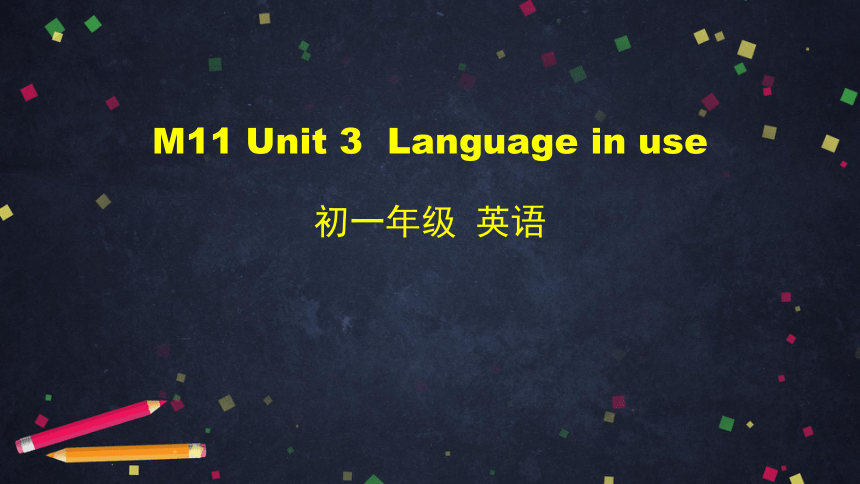 | |
| 格式 | zip | ||
| 文件大小 | 17.6MB | ||
| 资源类型 | 教案 | ||
| 版本资源 | 外研版 | ||
| 科目 | 英语 | ||
| 更新时间 | 2020-06-22 23:22:21 | ||
图片预览

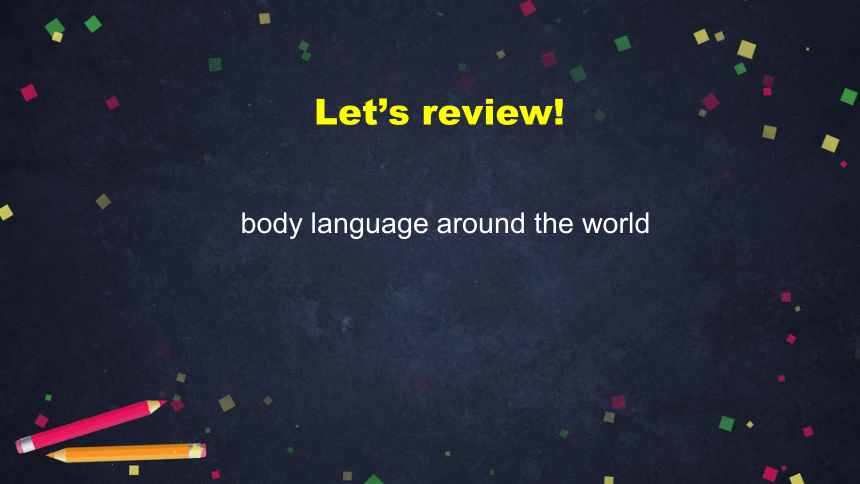
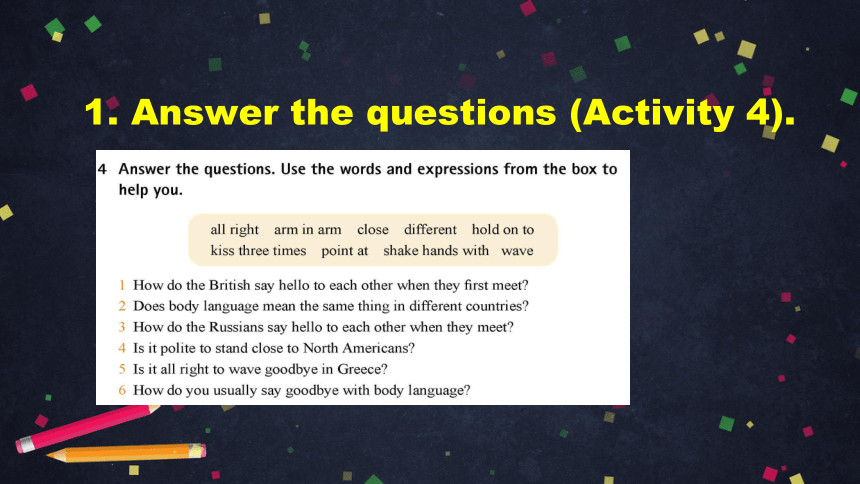

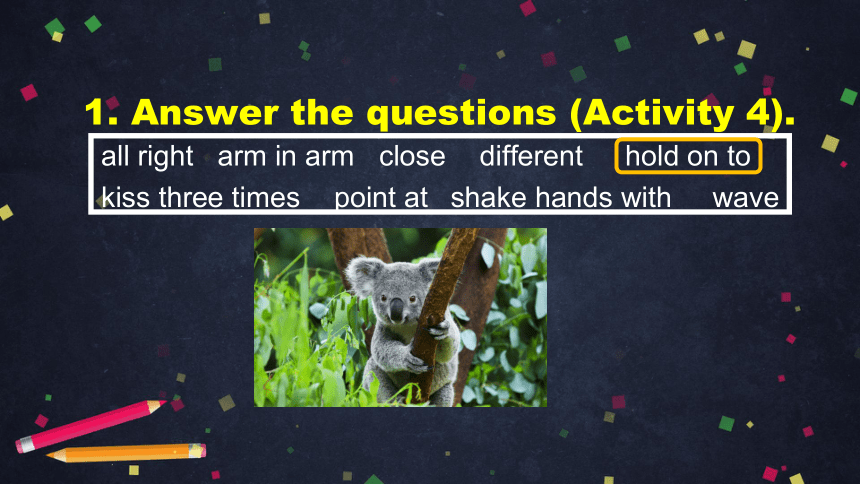
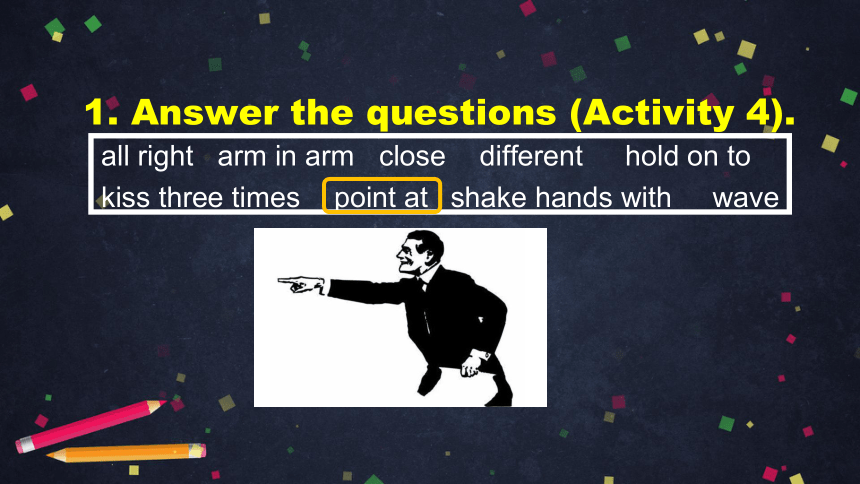


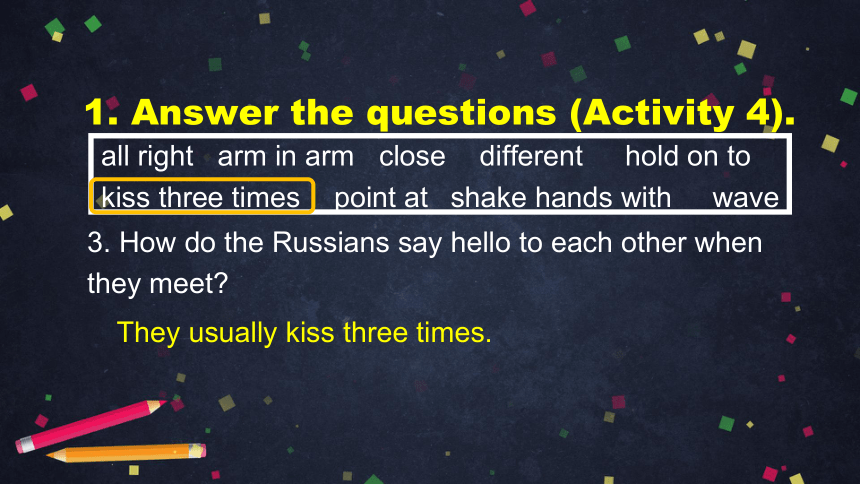
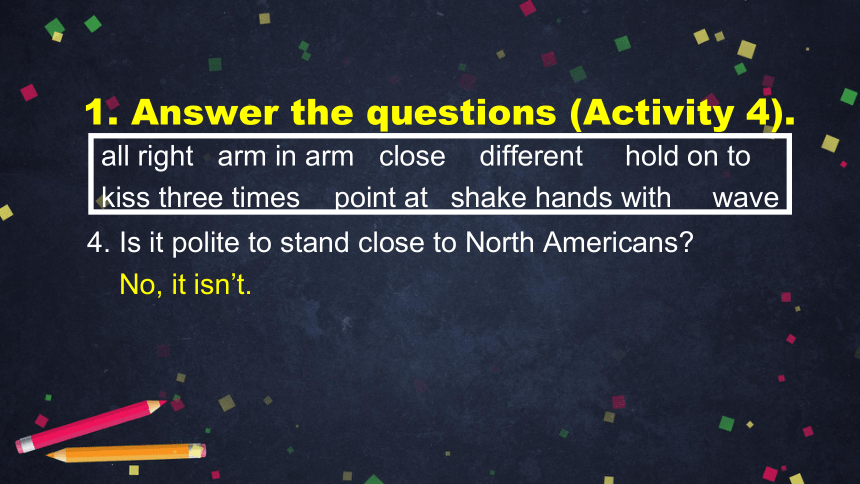
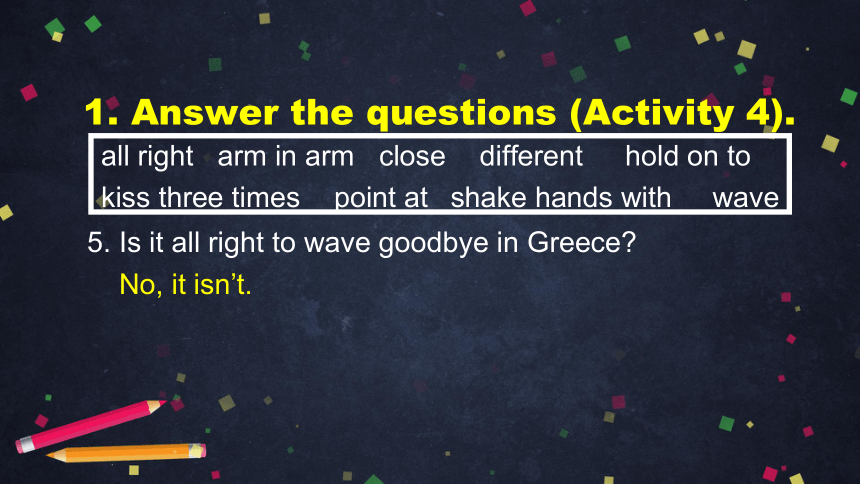
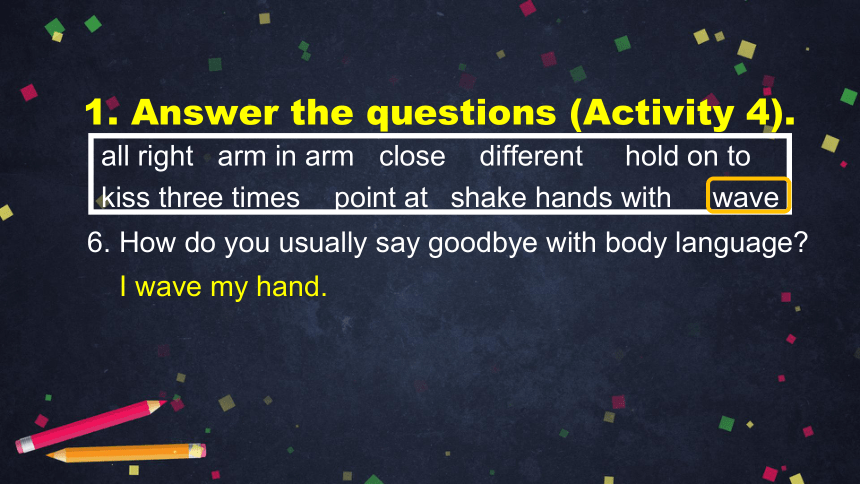
文档简介
(共69张PPT)
M11
Unit
3
Language
in
use
初一年级
英语
body
language
around
the
world
Let’s
review!
1.
Answer
the
questions
(Activity
4).
all
right
arm
in
arm
close
different
hold
on
to
kiss
three
times
point
at
shake
hands
with
wave
1.
Answer
the
questions
(Activity
4).
all
right
arm
in
arm
close
different
hold
on
to
kiss
three
times
point
at
shake
hands
with
wave
1.
Answer
the
questions
(Activity
4).
all
right
arm
in
arm
close
different
hold
on
to
kiss
three
times
point
at
shake
hands
with
wave
1.
Answer
the
questions
(Activity
4).
all
right
arm
in
arm
close
different
hold
on
to
kiss
three
times
point
at
shake
hands
with
wave
1.
Answer
the
questions
(Activity
4).
1.
How
do
the
British
say
hello
to
each
other
when
they
first
meet?
They
shake
hands
with
each
other.
all
right
arm
in
arm
close
different
hold
on
to
kiss
three
times
point
at
shake
hands
with
wave
1.
Answer
the
questions
(Activity
4).
2.
Does
body
language
mean
the
same
thing
in
different
countries?
No,
it
doesn’t.
all
right
arm
in
arm
close
different
hold
on
to
kiss
three
times
point
at
shake
hands
with
wave
1.
Answer
the
questions
(Activity
4).
3.
How
do
the
Russians
say
hello
to
each
other
when
they
meet?
They
usually
kiss
three
times.
all
right
arm
in
arm
close
different
hold
on
to
kiss
three
times
point
at
shake
hands
with
wave
1.
Answer
the
questions
(Activity
4).
4.
Is
it
polite
to
stand
close
to
North
Americans?
No,
it
isn’t.
all
right
arm
in
arm
close
different
hold
on
to
kiss
three
times
point
at
shake
hands
with
wave
1.
Answer
the
questions
(Activity
4).
5.
Is
it
all
right
to
wave
goodbye
in
Greece?
No,
it
isn’t.
all
right
arm
in
arm
close
different
hold
on
to
kiss
three
times
point
at
shake
hands
with
wave
1.
Answer
the
questions
(Activity
4).
I
wave
my
hand.
6.
How
do
you
usually
say
goodbye
with
body
language?
Around
the
world
respect
n/v.尊重
The
Japanese
bow
Do’s
Don’ts
Britain
Stand
in
line.
Shake
hands.
Say
“please”
and
“thank
you”.
Open
doors
for
others.
Look
at
people
when
you
talk.
Touch
people.
Ask
a
woman’s
age.
Stand
too
close.
Say
anything
too
personal.
2.
Read
and
talk
(Activity
1).
personal
adj.私人的
Possible
answers
to
help
visitors
to
Britain:
Shake
hands
when
you
meet
a
friend.
Do
stand
in
line.
Please
talk
about
weather.
Do
say
“please”
and
“thank
you”.
Do
look
at
people
when
you
talk.
3.
Read
and
list
(Activity
2).
Possible
answers
to
help
visitors
to
Britain:
Don’t
touch
people.
Don’t
ask
people
personal
questions.
Don’t
ask
a
woman’s
age.
Don’t
talk
with
food
in
your
mouth.
Don’t
be
late.
3.
Read
and
list
(Activity
2).
4.
Think
and
list.
Do’s
and
Don’ts
to
help
visitors
to
China:
Use
“Nin
Hao”
to
greet
older
Chinese
people.
Always
give
or
receive
your
gift
with
both
hands.
Wait
for
the
elders
to
move
the
chopsticks
before
you
begin
to
eat.
4.
Think
and
list.
Do’s
and
Don’ts
to
help
visitors
to
China:
Don’t
tap
(敲)
your
chopsticks.
Don’t
stick
your
chopsticks
upright
(直立的)
in
the
rice
bowl.
Don’t
open
your
gift
in
front
of
the
person
who
gave
it
to
you.
Stand
in
line.
Shake
hands.
Don’t
ask
a
woman’s
age.
Don’t
stand
too
close.
Imperative
Sentences
祈使句
Positive
Sentences
肯定句
Negative
Sentences
否定句
What
kind
of
sentences
are
they?
Usages
用法:用于表达叮嘱、劝告、希望、禁止、请求、或命令等。
Rules
规则:祈使句无主语;主语you常省去;动词原形当谓语,Don’t句首变否定;加强语气加感叹号!
Imperative
sentences
祈使句
(1)
Be
quiet
for
a
moment.
(2)
Make
your
own
rules.
(3)
Let’s
do
this
together.
Positive
Sentences
肯定句
be+形容词/名词
实义动词原形+其他
Let+宾语+动词原形+其他
(1)
Don’t
eat
in
the
classroom.
(2)
Let’s
not
say
anything.
(3)
Never
judge
a
person
by
looks.
Negative
Sentences
否定句
Don’t
+
动词原形
Let’s
+
not
+
动词原形
用否定副词never构成
+
动词原形
Examples:
It’s
important
to
listen
to
the
teacher.
Listen
to
the
teacher.
You
cannot
shout
in
the
classroom.
Don’t
shout
in
the
classroom.
5.
Rewrite
the
sentences
(Activity
3).
(1)
It’s
important
to
be
careful.
(2)
It’s
important
to
clean
and
tidy
the
lab.
Be
careful.
Clean
and
tidy
the
lab.
5.
Rewrite
the
sentences
(Activity
3).
(3)
You
cannot
touch
anything
if
the
teacher
doesn’t
ask
you
to.
(4)
You
cannot
bring
food
or
drink
into
the
lab.
Don’t
touch
anything
if
the
teacher
doesn’t
ask
you
to.
Don’t
bring
food
or
drink
into
the
lab.
5.
Rewrite
the
sentences
(Activity
3).
(5)
You
cannot
enter
the
lab
alone.
Don’t
enter
the
lab
alone.
5.
Rewrite
the
sentences
(Activity
3).
(1)咱们一起玩吧!
(2)请不要迟到。
Let’s
play
together.
Don’t
be
late,
please.
6.
Let’s
translate.
(3)回答这个问题。
(4)不要这么吵。
Answer
the
question.
Don’t
make
such
a
noise.
6.
Let’s
translate.
(5)上课安静。
(6)不要随处乱扔垃圾。
Be
quiet
in
class.
Don’t
throw
rubbish
everywhere.
6.
Let’s
translate.
(7)不打架不说脏话。
(8)请假。
Don’t
fight
or
say
rude
words.
Ask
for
leave.
6.
Let’s
translate.
6.
Let’s
translate.
(9)友好待同学。
Be
friendly
to
your
classmates.
7.
Make
a
poster
about
body
language.
Topic
A:
to
introduce
the
different
meanings
of
one
gesture
or
posture
in
different
countries
Topic
B:
to
introduce
different
body
language
to
show
the
same
meaning
in
different
countries
Topic
C:
to
introduce
body
language
in
one
particular
country
such
as
Britain,
the
US,
China,
etc.
Here
are
some
topics.
Topic
A:
different
meanings
of
one
gesture
or
posture
in
different
countries
What
you
think
it
means:
“Good
job.”
What
it
also
means:
Head-patting
is
a
little
strange
for
adults
to
do
to
anyone
but
kids,
but
it’s
very
bad
in
parts
of
Asia
like
Thailand,
Sri
Lanka
(斯里兰卡),
and
Laos
(老挝).
Patting
someone’s
head
What
you
think
it
means:
“Here’s
my
business
card.”
What
it
also
means:
Giving
with
one
hand
is
very
rude
in
countries
like
China,
Japan
and
Korea.
You
should
use
both
hands
to
give
your
very
important
business
card.
Giving
with
one
hand
What
you
think
it
means:
“OK.
No
problem!”
What
it
also
means:
In
France,
it
means
someone
is
worthless
(无用的).
In
Brazil
and
Turkey,
it
means
lots
of
mean
(刻薄的)
things.
"OK"
Topic
B:
different
body
language
to
show
the
same
meaning
in
different
countries
China:
People
usually
shake
hands
and
say
“Ni-Hao-Ma”
that
means
“How
are
you”.
They
may
also
bow
down
to
show
their
respect.
Different
ways
of
greeting
people
in
different
countries
India,
Thailand,
Laos
(老挝):
People
join
hands
in
a
praying
position
and
also
bow
if
the
other
person
is
elderly.
UK:
People
usually
shake
hands
when
they
meet
for
the
first
time.
Most
people
prefer
to
say
“Hello”
when
meeting
others.
USA:
Most
people
shake
hands
with
each
other
to
greet
when
they
meet.
Some
may
kiss
or
hug
each
other.
France:
A
handshake
is
often
accompanied
(伴随)
by
a
kiss
on
both
cheeks
(脸颊).
This
happens
every
time
they
meet
and
also
when
they
leave.
Mexico:
One
kiss
on
a
cheek
(脸颊)
is
enough
to
greet
others.
Greece:
People
usually
shake
hands
but
to
show
warmth,
they
also
hug
and
kiss.
Russia:
Handshake
is
common
today,
but
many
people
prefer
to
kiss
the
other
person
three
times
on
left,
right
and
then
left
cheek
(脸颊).
Italy:
Ciao
is
the
word
to
say
hello
to
each
other.
The
general
rule
is
to
give
one
or
two
kisses,
one
on
each
side.
Japan:
Japanese
bow
in
front
of
each
other
to
greet.
Maori
people:
These
natives
of
New
Zealand
touch
their
noses
to
greet
each
other.
In
most
of
the
Middle
Eastern
countries:
Men
shake
hands
followed
by
kissing
cheeks
(脸颊),
and
placing
the
left
hand
on
the
other’s
right
shoulder.
Topic
C:
body
language
in
one
particular
country
such
as
Britain,
the
US,
China,
etc.
Topic
C:
body
language
in
one
particular
country
such
as
Britain,
the
US,
China,
etc.
ways
of
saying
hello/goodbye
meaning
of
different
gestures
personal
space
touch
eye
contact
when
talking
...
ways
of
saying
hello/goodbye
meaning
of
different
gestures
personal
space
touch
eye
contact
when
talking
Topic
C:
body
language
in
China
ways
of
saying
hello/goodbye
People
usually
shake
hands
and
say
“Ni-Hao-Ma”
that
means
“How
are
you”.
They
may
also
bow
down
to
show
their
respect.
They
wave
to
say
goodbye.
Topic
C:
body
language
in
China
meaning
of
different
gestures
Topic
C:
body
language
in
China
1
3
meaning
of
different
gestures
Topic
C:
body
language
in
China
4
5
meaning
of
different
gestures
Topic
C:
body
language
in
China
6
7
meaning
of
different
gestures
Topic
C:
body
language
in
China
8
9
meaning
of
different
gestures
Topic
C:
body
language
in
China
10
10
meaning
of
different
gestures
Topic
C:
body
language
in
China
Typical(典型的)Peace
Sign
for
Taking
Pictures
meaning
of
different
gestures
Topic
C:
body
language
in
China
Make
“Okay”
with
Your
Fingers
meaning
of
different
gestures
Topic
C:
body
language
in
China
Pinky
Promise
meaning
of
different
gestures
Topic
C:
body
language
in
China
Fist
and
Palm
Salute
拱手礼
meaning
of
different
gestures
Topic
C:
body
language
in
China
Point
at
Someone
meaning
of
different
gestures
Topic
C:
body
language
in
China
Use
Your
Finger
to
Ask
Someone
personal
space:
Topic
C:
body
language
in
China
try
to
keep
a
comfortable
space
touch/kiss:
Topic
C:
body
language
in
China
hug/kiss
people
carefully
eye
contact:
Topic
C:
body
language
in
China
have
a
brief(简短的)eye
contact
Finish
your
poster
and
share
with
your
classmates
online
if
possible.
Homework
Thank
you
for
listening.
M11
Unit
3
Language
in
use
初一年级
英语
body
language
around
the
world
Let’s
review!
1.
Answer
the
questions
(Activity
4).
all
right
arm
in
arm
close
different
hold
on
to
kiss
three
times
point
at
shake
hands
with
wave
1.
Answer
the
questions
(Activity
4).
all
right
arm
in
arm
close
different
hold
on
to
kiss
three
times
point
at
shake
hands
with
wave
1.
Answer
the
questions
(Activity
4).
all
right
arm
in
arm
close
different
hold
on
to
kiss
three
times
point
at
shake
hands
with
wave
1.
Answer
the
questions
(Activity
4).
all
right
arm
in
arm
close
different
hold
on
to
kiss
three
times
point
at
shake
hands
with
wave
1.
Answer
the
questions
(Activity
4).
1.
How
do
the
British
say
hello
to
each
other
when
they
first
meet?
They
shake
hands
with
each
other.
all
right
arm
in
arm
close
different
hold
on
to
kiss
three
times
point
at
shake
hands
with
wave
1.
Answer
the
questions
(Activity
4).
2.
Does
body
language
mean
the
same
thing
in
different
countries?
No,
it
doesn’t.
all
right
arm
in
arm
close
different
hold
on
to
kiss
three
times
point
at
shake
hands
with
wave
1.
Answer
the
questions
(Activity
4).
3.
How
do
the
Russians
say
hello
to
each
other
when
they
meet?
They
usually
kiss
three
times.
all
right
arm
in
arm
close
different
hold
on
to
kiss
three
times
point
at
shake
hands
with
wave
1.
Answer
the
questions
(Activity
4).
4.
Is
it
polite
to
stand
close
to
North
Americans?
No,
it
isn’t.
all
right
arm
in
arm
close
different
hold
on
to
kiss
three
times
point
at
shake
hands
with
wave
1.
Answer
the
questions
(Activity
4).
5.
Is
it
all
right
to
wave
goodbye
in
Greece?
No,
it
isn’t.
all
right
arm
in
arm
close
different
hold
on
to
kiss
three
times
point
at
shake
hands
with
wave
1.
Answer
the
questions
(Activity
4).
I
wave
my
hand.
6.
How
do
you
usually
say
goodbye
with
body
language?
Around
the
world
respect
n/v.尊重
The
Japanese
bow
Do’s
Don’ts
Britain
Stand
in
line.
Shake
hands.
Say
“please”
and
“thank
you”.
Open
doors
for
others.
Look
at
people
when
you
talk.
Touch
people.
Ask
a
woman’s
age.
Stand
too
close.
Say
anything
too
personal.
2.
Read
and
talk
(Activity
1).
personal
adj.私人的
Possible
answers
to
help
visitors
to
Britain:
Shake
hands
when
you
meet
a
friend.
Do
stand
in
line.
Please
talk
about
weather.
Do
say
“please”
and
“thank
you”.
Do
look
at
people
when
you
talk.
3.
Read
and
list
(Activity
2).
Possible
answers
to
help
visitors
to
Britain:
Don’t
touch
people.
Don’t
ask
people
personal
questions.
Don’t
ask
a
woman’s
age.
Don’t
talk
with
food
in
your
mouth.
Don’t
be
late.
3.
Read
and
list
(Activity
2).
4.
Think
and
list.
Do’s
and
Don’ts
to
help
visitors
to
China:
Use
“Nin
Hao”
to
greet
older
Chinese
people.
Always
give
or
receive
your
gift
with
both
hands.
Wait
for
the
elders
to
move
the
chopsticks
before
you
begin
to
eat.
4.
Think
and
list.
Do’s
and
Don’ts
to
help
visitors
to
China:
Don’t
tap
(敲)
your
chopsticks.
Don’t
stick
your
chopsticks
upright
(直立的)
in
the
rice
bowl.
Don’t
open
your
gift
in
front
of
the
person
who
gave
it
to
you.
Stand
in
line.
Shake
hands.
Don’t
ask
a
woman’s
age.
Don’t
stand
too
close.
Imperative
Sentences
祈使句
Positive
Sentences
肯定句
Negative
Sentences
否定句
What
kind
of
sentences
are
they?
Usages
用法:用于表达叮嘱、劝告、希望、禁止、请求、或命令等。
Rules
规则:祈使句无主语;主语you常省去;动词原形当谓语,Don’t句首变否定;加强语气加感叹号!
Imperative
sentences
祈使句
(1)
Be
quiet
for
a
moment.
(2)
Make
your
own
rules.
(3)
Let’s
do
this
together.
Positive
Sentences
肯定句
be+形容词/名词
实义动词原形+其他
Let+宾语+动词原形+其他
(1)
Don’t
eat
in
the
classroom.
(2)
Let’s
not
say
anything.
(3)
Never
judge
a
person
by
looks.
Negative
Sentences
否定句
Don’t
+
动词原形
Let’s
+
not
+
动词原形
用否定副词never构成
+
动词原形
Examples:
It’s
important
to
listen
to
the
teacher.
Listen
to
the
teacher.
You
cannot
shout
in
the
classroom.
Don’t
shout
in
the
classroom.
5.
Rewrite
the
sentences
(Activity
3).
(1)
It’s
important
to
be
careful.
(2)
It’s
important
to
clean
and
tidy
the
lab.
Be
careful.
Clean
and
tidy
the
lab.
5.
Rewrite
the
sentences
(Activity
3).
(3)
You
cannot
touch
anything
if
the
teacher
doesn’t
ask
you
to.
(4)
You
cannot
bring
food
or
drink
into
the
lab.
Don’t
touch
anything
if
the
teacher
doesn’t
ask
you
to.
Don’t
bring
food
or
drink
into
the
lab.
5.
Rewrite
the
sentences
(Activity
3).
(5)
You
cannot
enter
the
lab
alone.
Don’t
enter
the
lab
alone.
5.
Rewrite
the
sentences
(Activity
3).
(1)咱们一起玩吧!
(2)请不要迟到。
Let’s
play
together.
Don’t
be
late,
please.
6.
Let’s
translate.
(3)回答这个问题。
(4)不要这么吵。
Answer
the
question.
Don’t
make
such
a
noise.
6.
Let’s
translate.
(5)上课安静。
(6)不要随处乱扔垃圾。
Be
quiet
in
class.
Don’t
throw
rubbish
everywhere.
6.
Let’s
translate.
(7)不打架不说脏话。
(8)请假。
Don’t
fight
or
say
rude
words.
Ask
for
leave.
6.
Let’s
translate.
6.
Let’s
translate.
(9)友好待同学。
Be
friendly
to
your
classmates.
7.
Make
a
poster
about
body
language.
Topic
A:
to
introduce
the
different
meanings
of
one
gesture
or
posture
in
different
countries
Topic
B:
to
introduce
different
body
language
to
show
the
same
meaning
in
different
countries
Topic
C:
to
introduce
body
language
in
one
particular
country
such
as
Britain,
the
US,
China,
etc.
Here
are
some
topics.
Topic
A:
different
meanings
of
one
gesture
or
posture
in
different
countries
What
you
think
it
means:
“Good
job.”
What
it
also
means:
Head-patting
is
a
little
strange
for
adults
to
do
to
anyone
but
kids,
but
it’s
very
bad
in
parts
of
Asia
like
Thailand,
Sri
Lanka
(斯里兰卡),
and
Laos
(老挝).
Patting
someone’s
head
What
you
think
it
means:
“Here’s
my
business
card.”
What
it
also
means:
Giving
with
one
hand
is
very
rude
in
countries
like
China,
Japan
and
Korea.
You
should
use
both
hands
to
give
your
very
important
business
card.
Giving
with
one
hand
What
you
think
it
means:
“OK.
No
problem!”
What
it
also
means:
In
France,
it
means
someone
is
worthless
(无用的).
In
Brazil
and
Turkey,
it
means
lots
of
mean
(刻薄的)
things.
"OK"
Topic
B:
different
body
language
to
show
the
same
meaning
in
different
countries
China:
People
usually
shake
hands
and
say
“Ni-Hao-Ma”
that
means
“How
are
you”.
They
may
also
bow
down
to
show
their
respect.
Different
ways
of
greeting
people
in
different
countries
India,
Thailand,
Laos
(老挝):
People
join
hands
in
a
praying
position
and
also
bow
if
the
other
person
is
elderly.
UK:
People
usually
shake
hands
when
they
meet
for
the
first
time.
Most
people
prefer
to
say
“Hello”
when
meeting
others.
USA:
Most
people
shake
hands
with
each
other
to
greet
when
they
meet.
Some
may
kiss
or
hug
each
other.
France:
A
handshake
is
often
accompanied
(伴随)
by
a
kiss
on
both
cheeks
(脸颊).
This
happens
every
time
they
meet
and
also
when
they
leave.
Mexico:
One
kiss
on
a
cheek
(脸颊)
is
enough
to
greet
others.
Greece:
People
usually
shake
hands
but
to
show
warmth,
they
also
hug
and
kiss.
Russia:
Handshake
is
common
today,
but
many
people
prefer
to
kiss
the
other
person
three
times
on
left,
right
and
then
left
cheek
(脸颊).
Italy:
Ciao
is
the
word
to
say
hello
to
each
other.
The
general
rule
is
to
give
one
or
two
kisses,
one
on
each
side.
Japan:
Japanese
bow
in
front
of
each
other
to
greet.
Maori
people:
These
natives
of
New
Zealand
touch
their
noses
to
greet
each
other.
In
most
of
the
Middle
Eastern
countries:
Men
shake
hands
followed
by
kissing
cheeks
(脸颊),
and
placing
the
left
hand
on
the
other’s
right
shoulder.
Topic
C:
body
language
in
one
particular
country
such
as
Britain,
the
US,
China,
etc.
Topic
C:
body
language
in
one
particular
country
such
as
Britain,
the
US,
China,
etc.
ways
of
saying
hello/goodbye
meaning
of
different
gestures
personal
space
touch
eye
contact
when
talking
...
ways
of
saying
hello/goodbye
meaning
of
different
gestures
personal
space
touch
eye
contact
when
talking
Topic
C:
body
language
in
China
ways
of
saying
hello/goodbye
People
usually
shake
hands
and
say
“Ni-Hao-Ma”
that
means
“How
are
you”.
They
may
also
bow
down
to
show
their
respect.
They
wave
to
say
goodbye.
Topic
C:
body
language
in
China
meaning
of
different
gestures
Topic
C:
body
language
in
China
1
3
meaning
of
different
gestures
Topic
C:
body
language
in
China
4
5
meaning
of
different
gestures
Topic
C:
body
language
in
China
6
7
meaning
of
different
gestures
Topic
C:
body
language
in
China
8
9
meaning
of
different
gestures
Topic
C:
body
language
in
China
10
10
meaning
of
different
gestures
Topic
C:
body
language
in
China
Typical(典型的)Peace
Sign
for
Taking
Pictures
meaning
of
different
gestures
Topic
C:
body
language
in
China
Make
“Okay”
with
Your
Fingers
meaning
of
different
gestures
Topic
C:
body
language
in
China
Pinky
Promise
meaning
of
different
gestures
Topic
C:
body
language
in
China
Fist
and
Palm
Salute
拱手礼
meaning
of
different
gestures
Topic
C:
body
language
in
China
Point
at
Someone
meaning
of
different
gestures
Topic
C:
body
language
in
China
Use
Your
Finger
to
Ask
Someone
personal
space:
Topic
C:
body
language
in
China
try
to
keep
a
comfortable
space
touch/kiss:
Topic
C:
body
language
in
China
hug/kiss
people
carefully
eye
contact:
Topic
C:
body
language
in
China
have
a
brief(简短的)eye
contact
Finish
your
poster
and
share
with
your
classmates
online
if
possible.
Homework
Thank
you
for
listening.
同课章节目录
- Module 1 Lost and found
- Unit 1 Whose bag is this?
- Unit 2 Are they yours?
- Unit 3 Language in use
- Module 2 What can you do ?
- Unit 1 I can play the piano
- Unit 2 I can run really fast
- Unit 3 Language in use
- Module 3 Making plans
- Unit 1 What are you going to do at the weekends?
- Unit 2 We're going to cheer the players.
- Unit 3 Language in use
- Module 4 Life in the future
- Unit 1 Everyone will study at home
- Unit 2 Every family will have a small plane.
- Unit 3 Language in use
- Module 5 Shopping
- Unit 1 What can I do for you?
- Unit 2 You can buy everything on the Internet
- Unit 3 Language in use
- Module 6 Around town
- Unit 1 Could you tell me how to get to the Nationa
- Unit 2 The London Eye is on your right.
- Unit 3 Language in use
- Revision module A
- Module 7 My past life
- Unit 1 I was born in a small village.
- Unit 2 I was born in Quincy.
- Unit 3 Language in use
- Module 8 Story time
- Unit 1 Once upon a time….
- Unit 2 Goldilocks hurried out of the house.
- Unit 3 Language in use
- Module 9 Life history
- Unit 1 He left school and began work at the age of
- Unit 2 He decided to be an actor.
- Unit 3 Language in use
- Module 10 A holiday journey
- Unit 1 What did you do?
- Unit 2 This morning we took a walk.
- Unit 3 Language in use
- Module 11 Body language
- Unit 1 They touch noses!
- Unit 2 Here are some ways to welcome them.
- Unit 3 Language in use
- Module 12 Western music
- Unit 1 It's so beautiful!
- Unit 2 Vienna is the centre of European classical
- Unit 3 Language in use
- Revision module B
